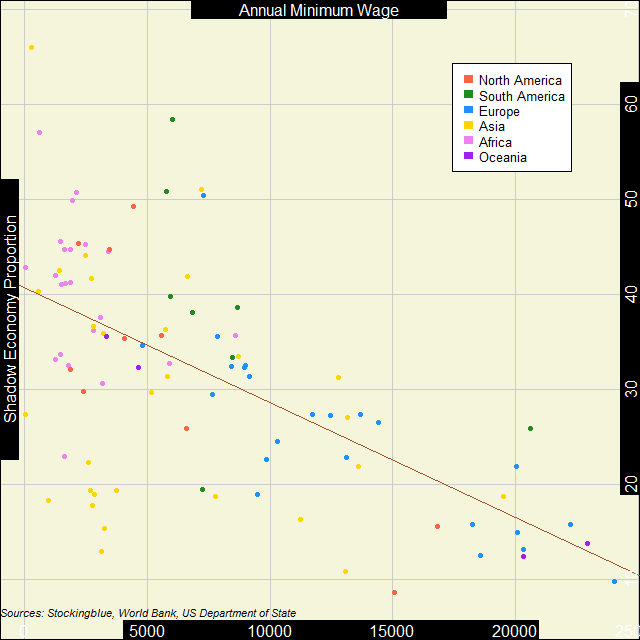
Worldwide, the inverse correlation between the strength of the shadow economy and the minimum wage is pretty strong. As the proportion of the shadow economy decreases, the minimum wage tends to go up.
Findings
- The correlation coefficient between per capita Gross Domestic Product (GDP) in Purchasing Power Parity (PPP) and minimum wage worldwide is -0.61.
- As the shadow economy increases, the minimum wage tends to decrease.
- North America has the country with the weakest shadow economy but that country only has the 13th highest minimum wage.
- Europe has the country with the second weakest shadow economy and the highest minimum wage.
- Asia has both the country with the lowest minimum wage which happens to have a moderate shadow economy and the country with the strongest shadow economy which also has one of the lowest minimum wages in the world.
- Only Asia has a country whose shadow economy takes up more than three-fifths of its overall economy.
Caveats
- As always, correlation does not imply causation.
- Several countries are not included as they were missing data. See the continent reports for complete lists.
- Minimum wages sometimes vary by profession and other variables.
Details
Although countries that tend to have higher minimum wages also tend to have weaker shadow economies, it is not always necessarily the case. It also raises an interesting question. Does a high minimum wage lead to a weaker shadow economy or does a weak shadow economy allow for a higher minimum wage - that is, assuming there is a causation which there may not be.
Worldwide, there may be a somewhat strong correlation between the two variables, but when looking at each continent individually there is a strong argument for no correlation between the two variables.
Sources
US Department of State. 2017. "Country Reports on Human Rights Practices for 2016." Accessed September 2, 2017. https://www.state.gov/j/drl/rls/hrrpt/humanrightsreport/index.htm#wrapper.
Schneider, Friedrich, Andreas Buehn, and Claudio E. Montenegro. 2010. "Shadow Economies All over the World: New Estimates for 162 Countries from 1999 to 2007." The World Bank Development Research Group.